Intel Core i7 4960X (Ivy Bridge E) Review
by Anand Lal Shimpi on September 3, 2013 4:10 AM EST- Posted in
- CPUs
- Intel
- Ivy Bridge
- Ivy Bridge-E
Video Transcoding
With our lightly threaded tests behind us, it's time to move to more CPU intensive pastures.
We migrated to the latest verison of the x264 HD benchmark which features a much newer version of x264 and a much heavier workload. The focus here is on quality rather than speed, thus the benchmark uses a 2-pass encode and reports the average frame rate in each pass.
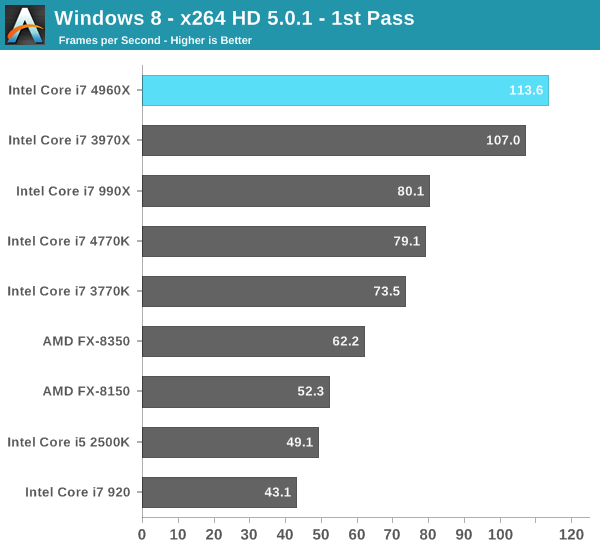

Here we see all of the 6-core parts rise to the top, including Intel's old Gulftown based Core i7-990X. Despite being a few years old at this point, the 990X's 6-core design and relatively high clock speed gives it better performance here than the quad-core Haswell 4770K.
The 4960X manages to be around 30% faster than the old 990X, and is 40% faster than the 4770K. For heavily threaded applications, there's simply no replacement for more cores.
Just like I did earlier, I dusted off one of our really old x264 tests so we'd have comparison data to even older CPUs including the Pentium 4 and Penryn based Extreme Edition parts:
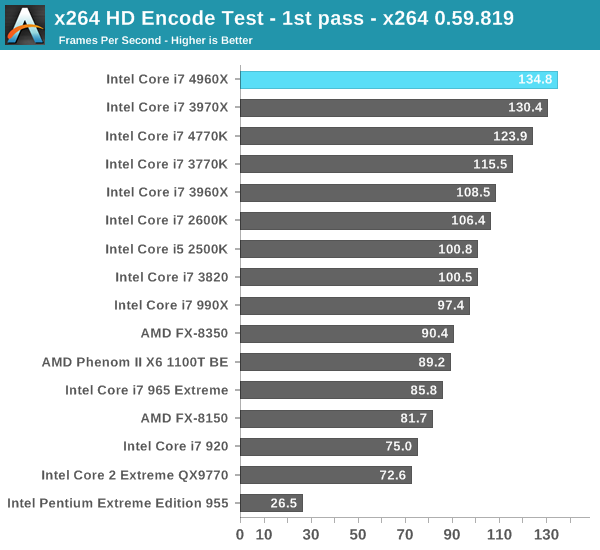
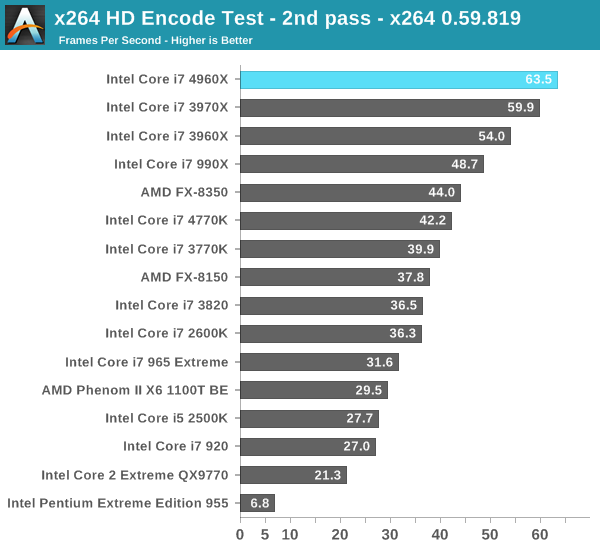
The 4960X manages to deliver nearly 3x the performance of Intel's flagship from 6 years ago. The Pentium EE 955 comparison is even more insane. IVB-E is basically an order of magnitude faster than the last high-end Pentium 4s to come out of Intel back in 2005.
3D Rendering
Our new POV-Ray benchmark uses the latest beta binary (3.7RC6) and runs through both single and multithreaded versions of the popular raytracing benchmark.
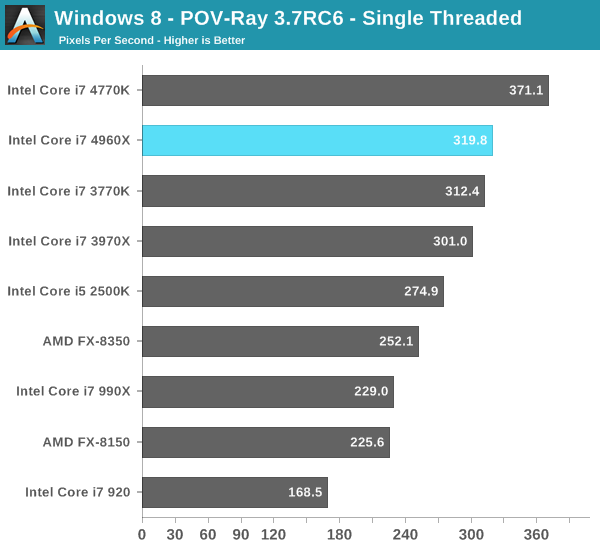
Isolating a single core shows us exactly what we're missing by having Ivy Bridge at the heart of the 4960X instead of Haswell. Here the 4770K manages a 16% performance advantage over the 4960X, which costs 3x as much and draws substantially more power. Looking at AMD's FX-8350 however it's clear why Intel can get away with launching a high-end 6-core chip without its latest cores. Piledriver's single threaded performance falls somewhere between Nehalem and Sandy Bridge, giving Intel room to launch another Ivy Bridge based high-end SKU in 2013 and get away with it.
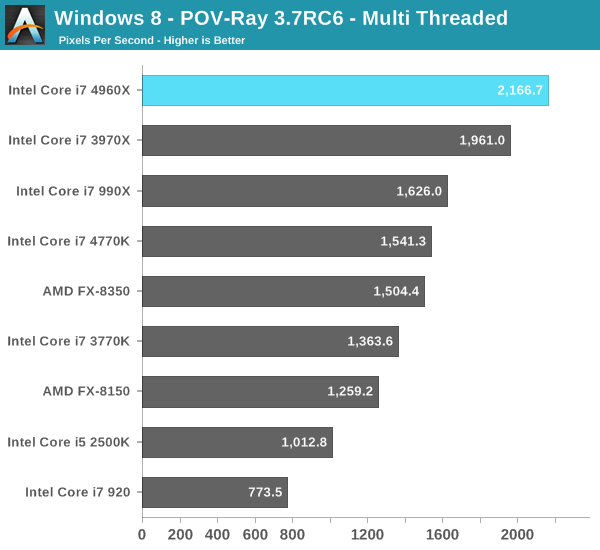
The multithreaded performance story is very different. Here even the Gulftown based 990X is faster than Haswell thanks to its six cores. The 4960X is 40% faster than the Haswell based 4770K. Even AMD's FX-8350 does really well here, basically equalling Haswell's performance.
Created by the Cinema 4D folks we have Cinebench, a popular 3D rendering benchmark that gives us both single and multi-threaded 3D rendering results.
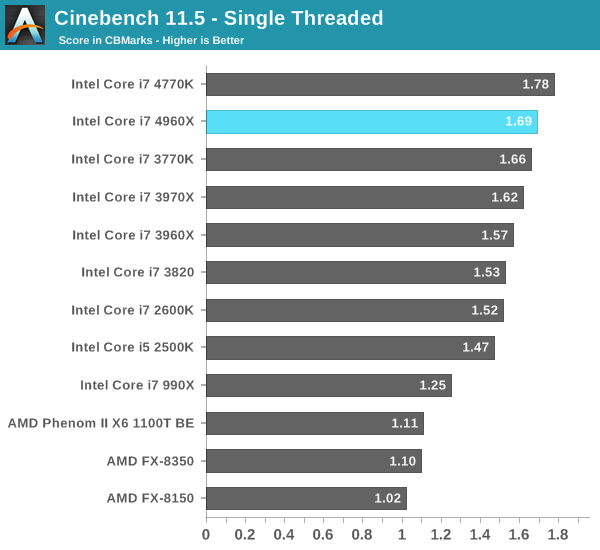
In Cinebench, the single threaded Haswell/IVB-E gap narrows to 5%.
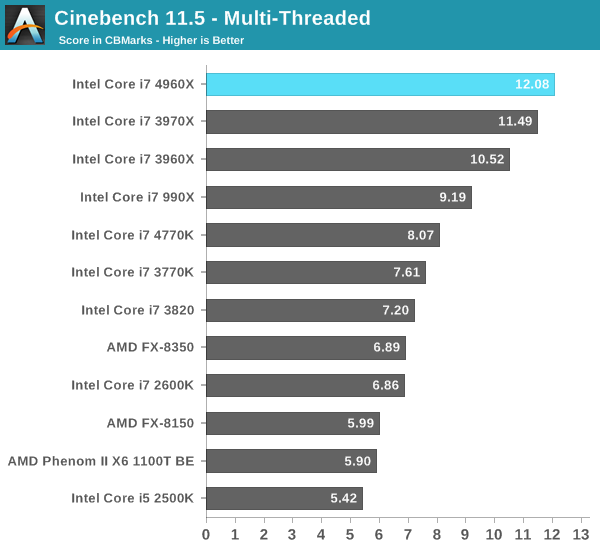
Multithreaded performance continues to be just stellar. Here the 4960X is just under 50% faster than the 4770K. Note the relatively small gap between the 4960X and the SNB-E based 3970X however - the performance gain is only 5%. The bulk of Ivy Bridge's advancements were in GPU performance (not applicable to IVB-E) and power consumption (which we'll get to shortly).
Our final two Cinebench tests use the R10 benchmark to enable a comparison to more/older data points:
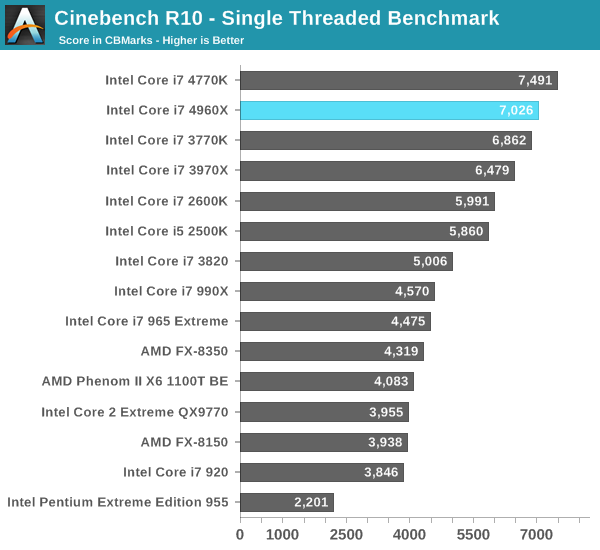
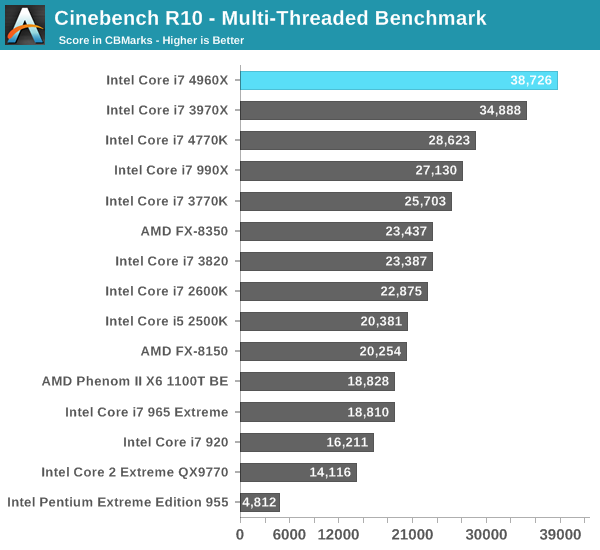










120 Comments
View All Comments
chadwilson - Tuesday, September 3, 2013 - link
Is the IHS soldered or using the cheap termal material? The issue with desktop IB & Haswell overclockability has been proven to be the cheap thermal material between the chip and IHS. If they have a soldered chip to IHS then this will be a decent upgrade over straight IB.BrightCandle - Tuesday, September 3, 2013 - link
Considering the power consumption, clock speed, overclock and temperature obtained its looking most like this is the same interface as SB-E - ie its soldered. Not that it makes much difference as just like SB-E it doesn't actually overclock all that well compared to its 4 core sibling.MrSpadge - Tuesday, September 3, 2013 - link
Look at the results: temperature is not the main problem any more due to the bigger die, but OC is still not good at 4.3 GHz / 1.4 V. Actually I'd say this is ridiculously bad compared to earlier 22 nm chips (my Ivy can do this at ~1.1 V).And I recently got a 3770K which requires 1.11 V to even hit 4.0 GHz! Seems to me Intels current process is to blame for Haswell OC rather than the thermal paste. Sure, temps drop when replacing the paste.. but OC doesn't improve all that much, does it? And if Ivy and Ivy-E don't clock all that well either...
Shadowmaster625 - Tuesday, September 3, 2013 - link
If SNB-E @ 435 mm^2 fit into 130W then they could have made IVB-E @ 435 mm^2 fit into about the same power envelope. If they had to drop the clocks a couple hundred MHz then that's a small price to pay for 10 cores.Kevin G - Wednesday, September 4, 2013 - link
Actually, the core count for the larger Ivy Bridge-E goes up to 12.adamantinepiggy - Tuesday, September 3, 2013 - link
So do these CPU use actual solder under the lid or crappy paste like the 4770K?noeldillabough - Tuesday, September 3, 2013 - link
Oh I've waiting for this! Now the most important question to me...which motherboard is everyone getting an Ivy Bridge-E going to use? I'm doing a custom water cooled loop if that makes any difference.diceman2037 - Tuesday, September 3, 2013 - link
Anand, that marketing image is suffering from a typo, "18% Lower" refers to power utilized, not performance.DMCalloway - Tuesday, September 3, 2013 - link
Wow! 40 PCIe lanes sounds great until you remember skt. 2011 still only supports two 'true' sata3 ports and no native usb3. PCIe storage is never a smooth experience. It's a shame Intel seems unconcerned with power users that are not enterprised based.randfee - Tuesday, September 3, 2013 - link
What a shame these don't support ECC memory! I want it back for the enthusiast!I'm a scientist, what am I supposed to purchase (privately)? I want a beefy machine for physics simulations at home that run for days/weeks i.e. What if a privat person wants to run several VMs?
The E-series would provide nice performance, but no ECC, what a shame!
Right now one has to pick between speed without ECC (chances are the crashes on you) or a chip with relatively slow performance (clock wise) to get ECC, at the same price point. The highend XEON CPUs are out of the question.
@ Anand, please point out to the Intel representatives you meet that there's a market for this! One has to consider AMD at this point, they offer many threads + ECC for a consumer price point. Granted, they're slower, but the premium for the Intel chips with ECC is just out of proportion for private use.